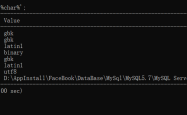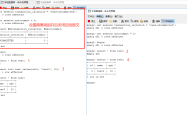MySql中流程控制函数/统计函数/分组查询用法解析
吾爱主题
阅读:546
2024-04-05 16:22:04
评论:0
路漫漫其修远兮,吾将上下而求索,又到了周末,我继续带各位看官学习回顾mysql知识。
上次说到了流程控制函数,那就从流程控制函数来继续学习吧!
?| 1 2 3 4 5 6 | #五.流程控制函数 #1.if函数:if else 的效果 if(条件表达式,成立返回1,不成立返回2) #与java三元运算相同 select if(10>5, '大' , '小' ); |

| 1 2 | select last_name,commission_pct,if(commission_pct is null , '没奖金呵呵' , '有奖金嘻嘻' ) as 备注 from employees; |

| 1 2 3 4 5 6 7 8 9 10 11 12 13 14 15 16 17 18 19 20 21 | #2. case 函数的使用一: swirch case 的效果【等值判断】 回顾:switch(变量或表达式){ case 常量1:语句1;break; ... default :语句n;break; } mysql中 case 要判断的字段或表达式或变量 when 常量1 then 要显示的值1或者语句1;[语句要加分号,值不用加] when 常量2 then 要显示的值2或者语句2; ... slse要显示的值n或者语句n;[默认值] end [结尾] case 在 select 后面相当于表达式用,后面不能放语句,只能是值. 在后续的学习中,存储过程与函数内就可以单独,用不搭配slect,就用语句. 先是表达式的操作 案例:查询员工的工资,要求 部门号=30,显示的工资为1.1倍 部门号=40,显示的工资为1.2倍 部门号=50,显示的工资为1.3倍 其他部门,显示的工资为原工资 |
| 1 2 3 4 5 6 7 8 | select salary 原始工资,department_id, case department_id when 30 then salary*1.1 when 40 then salary*1.2 when 50 then salary*1.3 else salary end as 新工资 from employees; |

| 1 2 3 4 5 6 7 8 9 | #2. case 函数的使用二:类是于多重if【区间判断】 回顾java中:if(条件1){ 语句1; } else if(条件2){ 语句2; }... else { 语句n; } |
| 1 2 3 4 5 6 7 8 9 10 11 12 | mysql中: case when 条件1 then 要显示的值1或者语句[语句后面要加分号;] when 条件2 then 要显示的值2或者语句[语句后面要加分号;] ... else 要显示的值n或语句n end 案例:查询员工的工资的情况 如果工资>20000,显示a级别 如果工资>15000,显示b级别 如果工资>10000,显示c级别 否则,显示d级别 |

==============流程函数到此结束,要想熟练运用还需要勤加练习。===============
提供几道习题供读者试试手!
?| 1 2 3 4 | #计算有几种工资。 select count ( distinct salary), count (salary) from employees; |

| 1 2 | #5. count 函数的详细介绍 select count (salary) from employees; |

| 1 2 | # count (统计所有列) select count (*) from employees; |

| 1 2 | #把表的行生成一个列每一列都是1。统计1的总数。 count 里面可以用任意常量值。 select count (1) from employees; |

| 1 2 3 4 | #考虑到效率问题: #5.5之前都是myisam 下 count (*)最高,计数器直接返回 #5.5之后默认都是innodb下 count ()与 count (1)都差不多, 比 count (字段)效率高,如果是字段要判断字段是否为 null 。 |
| 1 2 | #6.和分组函数一同查询的字段有限制 select avg (salary),employee_id from employees; |

| 1 2 3 | #1.查询公司员工工资的最大值,最小值,平均值,总和。 select max (salary), min (salary), avg (salary), sum (salary) from employees; |

| 1 2 3 | select max (salary) as 最大值, min (salary) as 最小值, round( avg (salary)) as 最小值, sum (salary) as 总和 from employees; |

| 1 2 3 | #2.查询员工表中最大入职时间和最小入职时间的相差天数。 #datediff计算天数。dateiff(参数1-参数2) select datediff(now(),( '1995-1-1' )); |

| 1 2 | select datediff( max (hiredate), min (hiredate)) as diffrence from employees; |

| 1 2 3 4 | #3.查询部门编号为90的员工个数。 select count (*) as 个数 from employees where department_id=90; |

| 1 2 3 4 5 6 7 8 9 10 11 12 | #进阶5.分组查询 group by 子句语法。 可以使用 group by 子句将表中的数据分成若干组。 语法: select 分组函数,列(要求出现在 group by 的后面) from 表 【 where 筛选条件】 grop by 分组的列表 【 order by 子句】 注意: 查询列表必须特殊,要求是分组函数和 group by 后出现的字段 特点: 1.分组查询中的筛选条件分为两类 |

| 1 2 3 | 2. group by 子句支持单个字段分组,多个字段分组(多个字段之间用逗号隔开没有顺序要求) 也支持表达式或函数分组(用的较少) 3.也可以添加排序(排序放在整个分组查询的最后) |

| 1 2 3 | #引入:查询每个部门的平均工资,保留两位小数。 select round( avg (salary),2) as 平均工资 from employees; |

| 1 2 3 4 5 | #简单的分组查询,添加分组前的筛选 where #案例1:查询每个工种的最高工资。 select max (salary) as 最高工资,job_id as 工种编号 from employees group by job_id; |

| 1 2 3 4 | #案例2:查询每个位置上的部门个数。 select count (*) as 总数,location_id from departments group by location_id; |

| 1 2 3 4 5 6 | #添加筛选条件 #查询邮箱中包含a字符的,平均工资保留两位小数,每个部门的平均工资 select email,round( avg (salary),2),department_id from employees where email like '%a%' group by department_id; |

| 1 2 3 4 5 | #案例2:查询每个领导手下员工有奖金的的最高工资 select max (salary),manager_id from employees where commission_pct is not null group by manager_id; |

| 1 2 3 4 5 6 | 添加复杂的筛选,添加分组后的筛选 having #案例1:查询哪个部门的员工个数>2 #①查询每个部门的员工个数 select count (*),department_id from employees group by department_id; |

| 1 2 3 4 5 | #②根据①的结果,查询哪个部门的员工个数>2 select count (*) as 总数,department_id as 部门编号 from employees group by department_id having count (*)>2; |

| 1 2 3 | #案例2.查询每个工种有奖金的员工的最高工资>12000的工种编号和最高工资。 #①查询每个工种有奖金的员工的最高工资。 #原始表能筛选的就放在 from 后面用 where 。 |
| 1 2 3 4 | select job_id as 员工编号, max (salary) as 最高工资 from employees where commission_pct is not null group by job_id; |

| 1 2 3 4 5 6 | #②根据①结果继续筛选,最高工资>12000。 select job_id as 员工编号, max (salary) as 最高工资 from employees where commission_pct is not null group by job_id having max (salary)>12000; |

| 1 2 3 4 5 6 | #案例3.查询领导编号>102的每个领导手下的最低工资>5000的领导编号是哪个,以及其最低工资。 #①查询领导编号>102的每个领导手下的最低工资 select min (salary) as 最低工资,manager_id as 领导编号 from employees where manager_id > 102 group by manager_id; |

| 1 2 3 4 5 6 | #②最低工资大于5000的。 select min (salary) as 最低工资,manager_id as 领导编号 from employees where manager_id > 102 group by manager_id having 最低工资 > 5000; |

| 1 2 3 4 5 6 7 | #案例:按员工姓名的长度分组,查询每一组的员工个数,筛选员工个数>5的有哪些 #mysql内 group by 与 having 后面支持别名, where 不支持别名。但oracle数据库的 group by 与 having 是不支持别名的。 select length(concat(last_name,first_name)) as 姓名长度, count (*) as 个数 from employees group by 姓名长度 having 姓名长度 > 5; |

| 1 2 3 4 5 | #按多个字段分组 #案例:查询每个部门工种的员工的平均工资(保留两位小数)。 select round( avg (salary),2) as 平均工资,department_id as 部门,job_id as 工种 from employees group by 部门,工种; |

| 1 2 3 4 5 6 | #添加排序 #案例:查询每个部门每个工种的员工的平均工资,并且按平均工资的高低显示。 select round( avg (salary),2) as 平均工资,department_id as 部门,job_id as 工种 from employees group by 工种,部门 order by 平均工资 desc ; |

| 1 2 3 4 5 6 | #案例:查询部门不能为空的,每个部门每个工种的员工的平均工资,并且按平均工资的高低显示。 select round( avg (salary),2) as 平均工资,department_id as 部门,job_id as 工种 from employees where department_id is not null group by 工种,部门 order by 平均工资 desc ; |

| 1 2 3 4 5 6 7 | #案例:查询部门不能为空的,每个部门每个工种的员工的平均工资高于10000的,并且按平均工资的高低显示。 select round( avg (salary),2) as 平均工资,department_id as 部门,job_id as 工种 from employees where department_id is not null group by 工种,部门 having 平均工资 > 10000 order by 平均工资 desc ; |

加强练习:
?| 1 2 3 4 5 | #1.查询各job_id的员工工资的最大值,最小值,平均值,总和,并按job_id升序。 select job_id, max (salary), min (salary), avg (salary), sum (salary) from employees group by job_id order by job_id asc ; |

| 1 2 3 4 5 6 | #2.查询员工最高工资和最低工资的差距(difference)。 select max (salary) - min (salary) as difference from employees; ======================================================= select max (salary) as 最高, min (salary) as 最低, max (salary)- min (salary) as difference from employees; |

| 1 2 3 4 5 6 | #3.查询各个管理者手下员工的最低工资,其中最低工资不能低于6000,没有管理者的员工不能计算在内。 select min (salary),concat(last_name,first_name),manager_id from employees where manager_id is not null group by manager_id having min (salary)>6000; |

到此结束,mysql的统计,分组查询到此结束。如果没有感觉的看官可以自己手动练习一下。
夏天的太阳总是那么亮的刺眼,但多沐浴一下阳光也补钙,想不到吧!o(^▽^)o
到此这篇关于mysql中流程控制函数/统计函数/分组查询用法解析的文章就介绍到这了,更多相关mysql 流程控制函数 统计函数 分组查询内容请搜索服务器之家以前的文章或继续浏览下面的相关文章希望大家以后多多支持服务器之家!
原文链接:https://www.cnblogs.com/jxearlier/p/13336822.html
声明
1.本站遵循行业规范,任何转载的稿件都会明确标注作者和来源;2.本站的原创文章,请转载时务必注明文章作者和来源,不尊重原创的行为我们将追究责任;3.作者投稿可能会经我们编辑修改或补充。










